陈圣元句子填空 section 71-88
陈圣元填空单词总结

9004.s43formidable: a.可怕的,令个畏惧的norm: n.标准,规范blizzard: n.暴风雨,大风雪inevitability: n.无可规避,注定发生ferocity: n.凶恶,凶猛,残忍,猛烈,强烈estreamline: v.1、使成为流线型 2、使现代化,使合理化精简(机构),提高效率automotive: a.1、汽车的 2、自动推进的milestone: n.1、里程碑(标) 2、(喻)里程碑,(历史的)重大事件breakthrough: n.1、《军》突围,突破性 2、(物价的)暴涨,(价值的)骤增3、(科技的)重大成就,突破性进展regression: n.后退,倒退,退化enurture: v.养育,培育,教养compensate for: v.弥补,补偿,抵消adversity: n.1、厄运,逆境,困境 2、痛苦,不幸,灾难exacerbate: v.1、使加深(剧),使恶化 2、激怒,使苦恼neutralize: v.使成为无效,抵消,使中立化eradicate: v.根除,杜绝ameliorate: v.改善,使变好relieve: v.减轻,缓解,舒缓eskyscraper: n.摩天大楼hint(at): v.暗示,示意cathedral: n.大教堂legitimize: v.1、使合法 2、证明...为有理(或正当)social strivings: n.社会追求evoke: v.唤起,使人联想起flout: v.藐视,蔑视,嘲讽eunorthodox: a.非正统的,异端的,叛经离道的methodology: n.1、(科学的)一套方法 2、方法论,方法学龄前 3、教学法unanimous: a.全体一致的,无异议的at once...and...: conj.既...又...,不仅...而且... pioneering: a.1、拓荒者的,开拓者的 2、先驱的,开拓性的,拓荒时期的compliment: v.称赞,恭维,祝贺mundane: a.1、尘世的,世俗的 2、单调的,平凡的decry: v.1、反对,遣责 2、诋毁unexceptionable: a.无懈可击的,无可指谪的,完美无缺的(exception 作名词时意为“反对,异议”,如take exception to,对...表示异议)eEmily Dickinson: n.迪更生(1830-1886,美国女诗人,美国现代诗先驱者之一)mistake...for...: v.把...误认为... simplemindedness: n.1、纯朴,天真无邪 2、头脑简单,无知,愚蠢 3、智能低下artlessness: n.单纯,天真,不谙世故,不诡计astonishment: n.1、惊讶,惊愕 2、令人惊讶的事物vexation: n.烦恼,伤脑筋,allusion: n.1、暗指,间接提到 2、引用典故,典故cunning: n.1、诡诈,狡猾 2、灵巧,熟练,精巧,巧妙制作es44long-range: a.1、长远的,未来的,长期的 2、远程的prototype: n.1、原型,样本 2、模范,典型reasoned: a.1、经缜密推断分析的,详尽论述的ultimate: a.最后的,最终的efrustrate: v.使灰心,使恼怒而不知所措be adapt at: v.熟练于,擅长于plausible: a.貌似有理(或真实)的ediscourse: n.1、论文 2、演讲 3、谈话 4、(语言学)语段parable: n.1、道德小故事,(说教性)寓言 2、谜一般的格言,隐晦的比较message: n.(作品的)启示,教训,寓意,中心思想communicate: v.1、传达,传播 2、传染 3、显露explictit: a.详述的,明确(晰)的,显然可见的,直言的,坦率的inferable: a.可推论(定)的discern: v.1、看出,觉察出 2、认识,了解 3、识别,区别,认出 4、辨明,分清illustrate: v.1、说明,阐明,显示 2、给...作插图说明 3、启发,启迪 4、照明ecircumspect: a.谨慎小心的,慎重的nonplus: v.使迷惑,使为难,使狼狈obsequious: a. 躬屈膝,拍马奉承的intransigent: a.不妥协的,不让步的,不调和的deferential: a.恭敬的,惯于顺从的negligent: a. 忽略的,粗心大意的eavailable: a.1、在手边的,现成可使用的,可利用的2、可获得的 3、可取得联系的,可接见的livestock: n.家畜,牲畜breeder: n.1、饲养动物的人 2、产仔的动物,繁殖的植物 3、来源,起因under development: n.在研制开发阶段中的reverse: v.使反向,使倒转,逆转,颠倒refine: v.1、提炼,精炼,精制 2、提去,炼去,减小3、净化,使...升华upgrade: v.1、使升级,提高 2、改良品种,提高质量supplement: v.1、增补,补充 2、补遗,附录,增刊 3、补给enecessitate: v.使成为必需,需要choose...over...: v.选择...而不选择...cereal: n.谷类植物(或食物)replenish: v.把...再备足,补充recourse(to): n.依靠(赖),求助eethology: n.1、(性格)形成学,道德体系学 2、(动物)个体生态学,行为学programming: n.程序编制instinctive: a.本能的,天性的,直觉的supersede: v.取代,替代compatible: a.能和睦相处的,合得来的,协调的 2、亲和的 3、可异花受精的transient: a.1、短暂的,转瞬即逝的,无常的 2、临时的,路过的complementary: a.1、补充的,补足的,互为补充的,相配的 2、互补的derive from: v.缘起于,导源于dictate: v.规定,支配,命令stereotyped:1、已成陈规的,刻板的 2、固定不变的,定型的e9010.s45nonviolent: a.非暴力的demonstration: n.游行示威,示威集会tension: n.1.拉紧,绷紧,拉紧状态 2.(精神上的)紧张 3.紧张局势,紧张状况injustice: n.1.非正义,不公正,不公平,侵犯权利 2.非正义的行为acknowledge: v.1.承认,承认...的权威性 2.告知, 确认3.就...表示谢忱,报偿还4.对...作出反应verify: v.1.证明, 证实 2.核实,查对,查清rolerate: v.1.忍受,容忍,宽恕 2.容许,不干预,承认,尊重address: v.对付,处理,解决eoscillate: v.1.摆动 2.犹豫,动摇,波动condescension: n.1.俯就,屈尊 2.傲慢,恩赐态度esteem: v.1.尊重,敬重 2.把...视作 3.评估dismissal: n.1.解散,打发走 2.解职,解雇,开除,撤职3.不予考虑 4.驳回诉讼adoration: n.崇拜,敬爱,倾慕disapproval: n.1.不赞成,反对,非难,不喜欢,不准许indifference: n.1.不感兴趣,不关心,冷淡,汪计较 2.不偏不倚,中立 3.无关紧要 4.平庸approbation: n.批准,满意,赞同precursor: n.1.先驱,先锋 2.先兆 3.前辈,前身eas yet: adv.迄今为止vegetation: n.1.植物生长 2.植物,草木,植被 3.呆板的生活ecosystem: n.生态系统ecologist: n.生态学家perfect: v.1.使完善 2.使完成 3.使精通hinder: v.阻碍,妨碍exhaust: v.详尽无遗地论述(或研究)prolong: v.拖延,延长eethical: a.道德的,伦理(学)的guideline: n.指导方针,原则,标准manipulate: v.1.操作,利用 2.巧妙地处理,操纵,控制alternative: a.供选择的,供替代的etechnocrat: n.1.技术专家政治论者 2.技术专家(官员)counterproductive: a.产生相反结果(或效果)的,适得其反的forsee: v.预见到ascertain: v.查明,弄清,确定exacerbate: v.1.使加深,使加剧,使每况愈下 2.激怒,使气恼ecartoonist: n.漫画家,动画片画家incredible: a.难于置信的,不可思议的comic strip: n.(报刊上的)连环漫画characterize: v.1.描绘,叙述 2.以...为特征draftmanship: n.1.起草术,制图术 2.草稿,图样sequencing: n.顺序排列,连续性virtuosity: n.1.精湛技艺 2.对艺术品的爱好与鉴赏3.(总称)艺术爱好者ecompromise: v.通过双方让步而和解,妥协negotiate a settlement: v.通过谈判百解决处理问题foreshadow: v.预示,兆示betray: v.1.背叛,失信于 2.泄露,(非故意地)显露,暴露alleviate: v.减轻,缓解cowardice: n.胆小,懦怯highlight: v.使显著,强调,突出es46allegation: n.1.断言,宣称 2.(有待证实的)指控,申辩misconduct: n.(官吏的)不法行为,不端行为,滥用职权ordeal: n.苦难经历,折磨煎熬unscathed: a.没有负伤的,未受操作的,未遭伤害的intact: a.完整无缺的,未受损伤的,未经触动的impair: v.1.削弱,减少 2.损害,伤害impugn: v.指责,非难,抨击,质疑tarnish: v.1.使失去光泽而变暗淡 2.蒙受羞辱,被玷污,受损害sully: v.弄脏,玷污,使推动光辉,使丢脸eappeal to: v.1.有感染力,有吸引力 2.求助于,诉诸于theme: n.题目,主题,主题思想democratic: a.1.民主的,民主政治的 2.平民大众的provincial: a.1.乡气的,粗野的,地方性的,偏狭的 2.相互平常的eultimately: adv.最后,最终dogmatically: adv.教条主义式的,固执己见地,武断地formulation: n.1.公式化表述,系统的阐述 2.规划,构想discredit: v.1.败坏...的名声,诽谤 2.使不可置信 3.不信,怀疑revert: v.1.回复,返回 2.重提assimilate: v.1.吸收,消化 2.使同化,使相似adhere: v.1.粘附 2.坚持固守 3.追随,拥护impose: v.加...强加于,加负担于,硬塞给incline: v.1.倾斜,曲身,弯腰点头 2.倾向,赞同,爱好3.趋向,倾向于 4.使有意于emerit: n.1.长处,优点,价值 2.功绩,功劳 3.功德,荣誉otherwise: adv.在其它方面,除此以外,以另外方式,原本gem: n.1.宝石 2.宝物,精品,精华petulant: a.1.任性的,脾气坏的 2.粗野的insightful: a.富于洞察力的,有深刻见解的acclaimed: a.深受赞誉和欢迎的harsh: a.1.粗陋的 2.来厉的,苛刻的,艰苦的undeserving: a.不配受到的,不该得到的eMagna Carta: n.大宪章(英史:1215年英国大封建领主迫使英王约翰签署的保障部分公民权和政治权的文件)provision: n.条文,条款,规定impact: n.1.碰撞,冲击(力) 2.影响,作用subject(to): a.臣服的隶属的,服从的,受支配的specific: a.1.明确的,具体的 2.特有的,特定的,独特的 3.有效的implicit: a.1.不言明的,含蓄的 2.内含的,固有的 3.元保留的,绝对的finite: a.1.有限的,有限制的 2.有限生存性质的,人类的3.有尽的,有穷的,非无限小的ecosmic: a.1.宇宙的 2.巨大无比的,无限的equilibrium: n.1.平衡,均衡 2.均势 3.(心情的)平静modulate: v.1.调节,调整 2.控制嗓音 3.抑扬地吟唱homogeneity: n.同种,同质,均匀性,相同性,同一性differentiate: v.1.使有差异 2.区分 3.使变异metamorphose: v.使变成,变形,变质proportion: n.1.比例 2.均衡,调和 3.容积,范围,程度 4.部分accelerate: v.1.使回忆,使增速 2.促进,促使...早日发生intelligibility: n.易于理解,清晰易懂einquisitive: a.好问的,爱钻研的,充满求知欲的,好奇的 2.爱打听他人隐私的presumptuous: a.专横的,自行其是的,傲慢的,冒昧的,放肆的venture: v.敢于做(或说),大胆表示censorious: a.吹毛求疵的,苛评的,好挑剔的umdercut: v.1.潜挖,从下切割,切除...的下部 2.凸雕,浮雕 3.削弱,暗中破坏moralistic: a.道德说教的e9102.s47astronomical: a.1.天文(学)的,天体的 2.巨大的assiduous: a.刻苦勤奋的 2.经常的,坚持不懈的claim: v.1.对(名声,财产)提出要求,认领,索取 2.声称有,拥有defiance: n.违抗,蔑(藐)视,挑战documentation: n.1.文件证据的记述编制 2.文献资料3.详尽引证maintenance: n.1.维持,保持 2.维修,养护,保养 3.坚持,主张 4.生计,生活资料 5.扶养domination: n.1.支配,统治,主宰,优势 2.宗主权,宗主地位emine: v.1.开采,从...提取天然成分 2.在地下挖坑道,暗中破坏have yet to: v.尚有待于enterprise: n.艰巨复杂(或带冒险性)的计划,雄心勃勃的事业accessible: a.1.易于接近的,可进入的 2.可使用的,易获得的3.(人)易相处的4.易懂的marginal: a.1.边比的,边沿地区的 2.边际的,勉强够格的,最低限度的3.微量的,不重要的subsidize: v.1.补贴,资助 2.用贿赂换得...的资助conserve: v.1.保护,保存 2.使永恒不灭evaledictory address: n.告别演说,知别辞literary: a.1.文学的 2.精通文学的,文人学士的 3.书面的clarity: n.1.清澈,明净 2.清晰,明晰genre: n.1.类型,体裁,样式 2.风俗画deviation: n.背离,偏离,偏差oration: n.演说,演讲grandiloquence: n.大言不惭,夸张,做作rigidity: n.1.坚硬刚性 2.严格,刻析,僵死egloss: n.1.光泽,光亮平滑的表面 2.虚假的外表,假象rationality: n.理性,合理性breach: v.1.破坏,违反 2.撕裂logical: a.1.逻辑(上)的,逻辑学的 2.符合逻辑的,有逻辑头脑的 3.按照逻辑发展的frail: a.脆弱的,易损坏的,身体虚弱的valiant: a.勇敢的,英勇的phobia: n.1.恐惧症 2.恐惧,憎恶ludicrous: a.滑稽有趣的,荒唐可笑的epassage: n.(时间的)消逝,推移soften: v.1.使变软,使软化,使缓和 2.使变暗,使变轻,使变淡 3.减轻,削弱hostile: a.1.敌方的 2.怀敌意的,不友善的,不利的revile: v.辱骂,痛斥scrutinize: v.详细检查(观察),细看econstruct: a.1.构成物 2.观念,概念,构念sound: a.1.强壮健康的 2.完好无病的 3.牢固的,可靠的 4.正确合理的,扎实的,精湛的aesthetically: adv.美学地,艺术地,审美地intuition: n.直觉intellectually: adv.埋智地,理性地surmise: n.推测,臆测,疑惑empirically: adv.以经验为根据际,经验主义地,经验上conjecture: n.猜测,揣摩educkling: n.小鸭,幼鸭identify: v.识别,确认,鉴定parent: n.[生]亲本,亲代,母体instinctive: a.本能的,出于天性的,直觉的bond: n.约束力,结合力,联结,纽带genetically: adv.1.创始的,起源的,发生的,自然生长的2.历史上的,发展的,演变的3.遗传学的impulse: n.1.推动,驱使,冲力,推力 2.推动作用,冲力作用.3.冲动,突然的欲望,一时的念头referent: n.所指事物(对象),关系项,参照物emulate: v.1.竭力赶超,与...竞争,比得上 2.仿效,模仿channel: n.1.海峡 2.河床 3.沟渠 4.途径,门径 5.官方渠道,正式程序mimic: v.1.模仿 2.(模拟地)戏弄es48mushroom: n.蘑菇,伞菌interaction: n.相互作用,相互影响edisjunction: n.分裂,分离objective: n.目标,宗旨individuality: n.个性,个人特征,独特性redundancy: n.1.过剩,多余 2.累赘,冗长eeliminate: v.1.排除,消除,根除 2.淘汰 3.不加考虑,忽视,略去folly: n.1.愚笨,愚蠢 2.蠢事,傻话innocuous: a.1.无害的,无毒的 2.无伤大雅的,平淡无味的fatal: a.1.致命的 2.毁灭性的 3.重大的,决定性的,决定命运的 4.命运的devastating: a.破坏性极大的,毁灭性的detrimental: a.有害的,不利的ein that: conj.因为subject matter: n.论题,题材,主要内容confound: v.1.使混淆,使惊慌失措 2.挫败repudiate: v.1.拒绝,否定,驳斥 2.断绝往来,脱离关系recapitulate: v.扼要复述,概述,总结,概括polarize: v.1.使极化 2.使两极分化,使两极对立elegislator: n.立法者,议会议员regulate: v.制约,控制,调节,整治secure: v.1.弄到,获得 2.招致,带来remuneration: n.酬报,赔偿,酬金statute: n.成文法,法规,章程intricacy: n.1.错综复杂,复杂精细 2.难以了解,难以理解futility: n.1.徒劳无益 2.无意义,无聊decadence: n.堕落,颓废,衰落ecutting edge: n.刀锋,最前沿common sense: n.常识,(由实际生活经验得来的)判断力radical" a.极端的,激进的incorporate: v.1.包含,吸收 2.使合并,使混合 3.具体化,体现absurd: a.荒谬的,荒诞的,愚蠢滑稽的corroborate: v.证实,确证eall the more: adv.更加,越发,格外,愈发,尤其deference: n.1.尊从,服从 2.敬重,尊敬uncanny: a.1.怪模怪样的,可怕的 2.离奇神秘的,不可思议的reserve: n.1.拘谨,矜持 2.严肃,节制e9104.s49Voyager: n.(美国)"旅行者"号行星探测器Jupiter: n.木星Saturn: n.土星Neptune: n.海王星elate: v.使兴高采烈,使得意扬扬,使兴奋eexclusively: adv.仅仅,专门地,单独地,排他地aggressive: a.活跃有为的,积极进取的entrepteneur: n.1.企业家 2.主办者 3.中间商,承包者aspiration: n.强烈,愿望,志向,抱负disagreeable: a.1.不合意的,令人不快的,讨厌的 2.不友善的,难相处的,脾气坏的vexation: n.苦恼,烦恼superfluous: a.1.过多的,过剩的,过量的 2.多余的,不必要的,不相干的3.(废)奢侈的,挥霍浪费的bane: n.1.毒物,祸根 2.死亡,毁灭prerogative: n.独有的权利,特权accessible: a.可(或易)使用的,可(或易)得到的elinguist: n.语言学家,通晓数国语言的人American Sign Language: n.(专为聋哑人设计的)北美式手势语implicit: a.含蓄的,不言明的 2.内在的,固有的 3.无疑问的,无保留的,绝对的syntactic: a.句法的economical: a.经济的,节约的,省俭的shifting: a.变化的,更换的abstract: a.1.抽象的 2.难解的,深奥的 3.纯理论的,不实际的4.空想的eadherence: n.1.坚持,遵守 2.依附,信奉 3.粘附martinet: n.1.严格执行军纪的军官 2.严格执行纪律(或规章制度)的人,恪守细技未节的人authority: n.1.权,权力,管辖权 2.当权者,行政管理机构 3.当局,官方 4.权威sporadic: a.1.不时发生的,断断续续的,零散的 2.独立的,个别的分散的tyrant: n.暴君,专制君主,独裁者fraud: n.欺骗,诡计,骗子conscientious: a. 1.按良心办事的,认真的,勤勤恳恳的 2.小心谨慎的,煞费苦心的acolyte: n.1.侍僧 2.(牧师举行仪式时的)助手maniacal: a.躁狂的,疯狂的,狂热的eTimaeus: n.<提马埃乌斯对话录>if only because: conj.假如是这样的话,仅仅是因为pervasive: a.1.到处弥漫渗透的 2.遍布的,流行的inestimable: a.1.难以计算的,无法估计的 2.极宝贵的,无价的suppress: v.1.压制,镇压,禁止,废止 2.禁止发表,查禁 3.抑制,阻止,隐瞒abridge: v.1.缩短 2.节略underestimate: v.低估,对...估计不足circumscribe: v.1.环绕,包围 2.限制,约束egiven: a.有癖好的,有倾向的,喜爱...的humility: n.1.谦逊,谦恭 2.谦恭的行为absurdity: n.荒谬,荒诞mediocrity: n.1.平庸,平凡 2.平庸的才能,平凡的成就 3.庸人confrontation: n.1.对质,比较 2.对抗,冲突conformism: n.因循守旧,墨守成规singularity: n.1.独一,罕有,非凡 2.奇特,独特ostentation: n.炫耀,夸示,卖弄eccentricity: n.古怪,怪癖epopular sovereignty: n.人民主权论,人民权利至上论humanistic: a.1.人道主义者 2.人本主义者 3.人文主义者,人文科学的,古典文化的discipline: n.学科,科目suffrage: n.投票,选举权recommendation: n.1.推荐 2.推荐信,口头推荐 3.劝告,建议safeguard: n.保卫(护),预防措施,保证条款excess: n.过度,无节制,(复)暴行,泛滥,滥用provision: n.条文,条款,规定es50survey: n.1.调查,查勘,检视,检验 2.测量,测绘 3.俯视,眺望management-training program: n.经营管理培训项目eflamboyant: a.火焰的,艳丽的,浮夸的private life: n.个人生活,私生活drab: a.1.黄褐的 2.单调乏味的,无光彩的sordid: a.1.肮脏污秽的 2.贫穷破烂的 3.贪婪的,下贱的discourteous: a.粗鲁失礼的,没礼貌的eloyalty: n.忠诚,忠心kin: n.家属,亲属,亲戚compatriot: n.同国人,同胞merge: v.合并,融合hierarchy: n.1.等级制度 2.分成待级的僧侣统治集团,僧侣统治,统治集团cognizance: n.认识,观察,注意eflourish: v.繁荣,盛行,茂盛,兴旺,处于旺盛期flounder: v.1.挣扎,踉跄 2.错乱地做事(或说话) constrain: v.1.强迫 2.限制,禁闭,抑制emelodrama: n.1.传奇剧,情节剧 2.音乐戏剧 3.传奇剧式的事件hiss: v.以嘘声压倒或嘲弄villain: n.1.恶棍 2.(小说戏剧中)反派人物smug: a.1.自鸣得意的 2.整洁的,体面的spurn: v.1.践踏,一脚踢开 2.轻蔑地拒绝或摈弃condescension: n.1.屈尊,俯就 2.傲慢或恩赐态度classify: v.1.把...分类,把...分级 2.把...归入某类 3.把归入保密级别self-righteousness: n.自以为正直或有善德,自以为是,伪善plausible: a.貌似有理或真实的,貌似可信的guilt: n.1.罪,犯罪,有罪,过失 2.内疚gripping: a.扣人心弦的,极吸引人的skepticism: n.1.怀疑态度 2.对宗教的怀疑 3.怀疑论,怀疑主义eassignment: n.1.任务,作业 2.分配,指派,选派amend: v.修改,改善,纠正,改进competent: a.1.胜任的,合格的 2.有效的,合适的swift: a.1.快速进行的,速度快的 2.迅速的,机警的 3.短暂的,突然的random: a.1.任意的,随机的 2.不受管束的,无定规的reconcile: v.使和解,调和edealer: n.商人fickle: a.易变无常的stock-market: n.股票市场amateur: n.1.业余爱好者,业余运动员 2.外行,粗通的人 3.爱好者sensible: a.1.明智的,明白整理的,合情理的,切合实际的2.知道的,意识到的,认识的3.明显的4.感觉到的erratic:a.1.不规则的 2.古怪的 3.游移的booming:激增的,兴旺发达的,迅速发展的insider: n.1.(组织,团体的)内部人员 2.知内情者,了解内幕的人irrational: a.1.无理性的 2.不合理的,荒谬的e9110.s51contrary to: prep.与...相反happy: a.幸运的hunch: n.基于直觉的想法,预感persistence: n.1.坚持不懈,执意 2.持续性,存留(状态)deduction: n.1.减除,扣除 2.演绎,推论etransition from... to...: n.由...向...的转折(或转变,过渡)Paleolithic: a.旧时器时代的Neolithic: a.新时器时代的picorial: a.1.绘画的 2.形象生动的degeneration: n.衰退,堕落,蜕化,倒退milestone: n.里程碑,里程碑式的重大事件debase: v.贬低(身份,人格,意义),贬值consolidation: n.1.巩固 2.联合,合并calamity: n.灾祸,巨大的苦难aberrant: a.偏离正路的,反常的,异常的regression: n.倒退,退化,回归sophisticated: a.1.复杂的,精密的,尖端的,高度发展的 2.老于世故的,失去天真的,矫揉造作的 3.老练的,富有经验的,精通的 4.不落浴套的,深奥微妙的,精致的epresence: n.存在all but(后接形容词或副词): adv.几乎(即等于almost) reassuring: a.安慰(性)的,鼓励(性)的,使人放心的,消除疑虑的trepidation: n.惊慌,悸惧endearing: a.引人喜爱的,表达钟爱之情的exhilaration: n.欢欣鼓舞,高兴,振奋eeradication: n.根除,杜绝legislation: n.1.立法,法律的制定(或通过) 2.法律,法规aesthetics: n.美学,审美哲学restoration: n.1.恢复 2.复元,整修 3.重新实施 4.归还,返还emangement: n.(企业,机关等的)管理人员,管理部门,经理部,资方print:报界electronic media: n.电台和电视一类的电子舆论媒体metropolitan: a.大都会的,大城市的all but(后接名词):除...之外的全部人(或事)abreast: a.齐头并进的,并肩的,不落后于...的keep abreast of(with): v.使与...齐头并进,使不落后于,使紧跟...的发展disclose: v.1.使显露 2.揭露,泄露,透露leak: v.1.渗漏 2.泄露(走漏)消息apprise: v.(正式)通知,告知withhold: v.1.使停止,阻挡 2.拒给 3.隐瞒speculate: v.1.猜测,推测,推断 2.思考,思索,深思默想,玄想ignorant: a.一无所知,不了解的ecase: n.[语法]格(如主格,宾语,所有格等) distinction: n.1.区分,差异,与众不同 2.殊荣,荣誉,著名licenseL: n.1.(艺术创作的)破格,不拘一格 2.放纵,淫荡rigidity: n.死板,僵化imperative: n.1.紧近的事,必要性 2.命令,规则eparadoxically: adv.矛盾的scrupulous: a.1.有顾忌的,有道德原则的 2.细致认真的,一丝不苟的.abandon: n.放纵,无拘无束,狂放,无节制passion: n.激情,热情,强烈情感,酷爱disinterested: a.1.公正无私的,无偏的 2.冷漠的,无兴趣的detachment: n.超脱,公正,不偏不倚es52apology: n.1.道歉,愧悔 2.辩护,辩解abject: a.1.绝望无援的,凄苦可怜的 2.可鄙的 3.奴性的,怯懦的etiquette: n.1.礼节,礼仪 2.道德规范,规矩sporadic: a.1.不时发生的,断断续续的,零散的 2.孤立的,个别的,偶发的,非流行性的dampen: v.1.使潮湿 2.使扫兴,使沮丧,抑制,减少,降低courteous: a.谦恭有礼的,殷勤的ceremonious: a.1.礼仪的 2.正式隆重的,拘泥于礼节的acrimonious: a.尖刻的,讥讽的,激烈的blur: v.1.使模糊不清 2.弄脏,涂污,玷污sarcastic: a.1.讽刺的,嘲笑的,挖苦的 2.尖刻的eweed: n.杂草,野草flourish: v.茂盛,繁荣,兴旺seedling: n.幼苗,秧苗thereby: adv.从而,因此indistinguishable: a.无法分辨的displace: v.1.移动...的位置 2.取代...的位置,置换3.撤换,免...的职epanel: n.1.专门小组,评判小组 2.陪审团feasible: a.1.可行的,行得通的 2.可能的,合理的,似真的mundane: a.世俗的,尘世的,单调平凡的eclectic: a.折中主义的,不拘一格的appealing: a.有感染力的,吸引人的grandiose: a.1.宏伟壮丽的 2.过分华丽的,浮夸做作的affordable: a.1.买得起的,担负得起的 2.提供的,给予的 3.赐予的visionary: a.幻想的,空想的,不切实际的elinguistics: n.语言学hobbyist: n.业余爱好者,沉溺于某种癖好者manifest: a.显然的,明了的,明白无误的plausible: a.貌似有理或真实的rudimentary: a.1.基本的,初步的,早期的 2.未成熟的,已退化的eidentify: v.1.认出,识别,确定 2.认为...等同于(with) 3.使参与,使支持(with)quirk: n.1.怪癖 2.俏皮话,遁辞,模棱两可 3.突发事件,形势的急转mannerism: n.1.对独特风格的过分模仿(或偏爱),矫揉造作 2.习作,怪癖3.(艺术)风格主义formula: n.1.俗套(话) 2.惯便,常规,程式decry: v.1.反对,谴责 2.诋毁superficial: a.1.面的,平方的 2.表面的,外部的3.表面性的,草率的,粗略的4.肤浅的prize: v.1.重视,珍视 2.估价,评价withstand: v.经受,承受,顶住,抵住eefficacious: a.有效验的,灵验的side effect: n.1.(药物)副作用 2.(事态的)意外后果outdated: a.过时的,老式的,已废弃的salutary: a.1.有利的 2.有益健康的edelegate: n.1.代表,会议代表,代表团团员 2.委员会委员the opposition: n.反对派(党)counterposition: n.相反的立场或观点dispirited: a.垂头丧气的,无精打采的surly: a.1.乖戾的,粗鲁的,敌意的 2.(天气)阴沉沉的resentment: n.1.仇恨,怨恨 2.[心]愤慨halfhearted: a.半心半意的,不热心的composure: n.镇静,沉着,克制vitriolic: a.1.硫酸的 2辛辣尖刻的,刻薄的civility: n.礼貌,客气,谦恭e9202.s53idiosyncratic: a.个人气质的,体现个人习性或癖好的dismiss: v.解雇,免...的职,开除insubordinate: a.不服从的,违抗的staff: n.全体职员,全体雇员,全体教员heretofore: adv.迄今为止institute: v.建立,设立,开创better: v.1.改善,提高 2.胜过.超过contravene: v.1.与...相抵触,违犯 2.反驳,否认jeopardize: v.危及,损害reiterate: v.反复做,反复重早,重述compute: v.计算,推断delimit: v.确定...的界线,限定econsensus: n.1.合意的 2.(意见的)一致objective: n.1.目的,目标,宗旨 2.可见的实物rest on: v.建立在...的基础上commonplace: a.1.无创见的,无淡无味的,平凡的,普遍的trivial: a.琐碎的,不重要的,无价值的explicit: a.详述的,明晰的,坦率的,显然可见的divergent: a.1.分叉,叉开的 2.有分歧的,不同的 3.偏离的eguilty: a.1.有罪的,证明(或判决)有罪的(of) 2.有过失的(of) 3.内疚的verdict: n.1.(陪审团的)裁定 2.定论acquittal: n.宣告无罪,无罪开释sensational: a.轰动性的,耸人听闻的impartial: a.不偏不倚的,公正的,无偏见biased: a.偏袒一方的,有偏见的denounce: v.1.谴责,指责,痛斥 2.告发,控告 3.通知废止eidealized: a.被理想化的medieval: a.1.中世纪的,中古时代的 2.老式的,守旧的trepidation: n.惊恐,悸惧exorcise: v.1.驱除,祓除(邪魔),给...洗罪 2.消除,除去affection: n.爱慕,恋情,倾慕surmount: v.克服,越过,登上disinterest: n.超然公正,客观无偏alleviate: v.使易于忍受,减轻,缓解confront: v.1.面临,遭遇 2.正视,对抗epaleontologist: n.古生物学家the Cambrian period: n.寒武纪(古生代的第一个纪) diversity of species: n.[生物]物种多样性imperfection in the fossil record: n.化石记录的不完整性decreased: a.下降的,减少的,缩减的escalation: n.逐步上升(增强,扩大),逐步升级stasis: n.静态平衡,停滞,静止deviatin: n.偏离,偏差,违背常规emanipulate: v.熟练地利用,操作,驾驭,操纵,处理tissue culture: n.(生物)组织培养hormone: n.激素,荷尔蒙be contingent on: v.依...条件而定,取决于work: v.起作用,有效cellular: a.细胞的eastronomer: n.天文学家feminist: n.妇女解放论者,女权主义者prodigious: a.1.庞大的,巨大的 2.异常的,惊人的vigor: n.1.精力,活力 2.强大的力量,气势,威力assertion: n.断言,主张thriving: a.兴旺的,繁荣的,昌盛的,蓬勃发展的prospering: a.昌盛的,繁荣的buttress: v.支持,支撑dormant: a.斩停活动的,中止的,暂搁不用的belie: v.证明...为虚假,与...抵触,违背quiescent: a.静止的,不活动的,静态的,休眠的es54mismanagement: n.经营失误,管理不善infusion: n.注入,灌输anything more than: adv.不只是(即等于not merely) woe: a.1.痛苦,悲哀,苦恼,悲伤 2.困难,灾难,不幸temporary: a.暂时的,临时的,短暂的genuine: a.真的,非人造的,名符其实的,真诚的eantibiotic: n.抗菌素,抗生素clinical: a.临床的,临床诊断的bacterial: a.细菌的breakthrough: n.突破性进展,重大成就panacea: n.治百病之灵药,万应药convenionally: adv.传统地,常规地,因循守旧地,因袭地resurgence: n.复活,复苏,再现emisconception: n.误解,错误想法novice: n.新手,初学者mirror: v.反映,折射出convoluted: a.1.盘绕卷曲的,回旋的 2.错综复杂的inconsequential: a. 1.微不足道的,细琐的 2.不连贯的,离题fanciful: a.z幻想的,异想天开的blatant: a.1.喧闹吵嚷的 2.炫耀的,俗丽的ehint: n.细微的迹象,少许,微量avert: v.1.避免,消除(灾祸等) 2.转移(视线或注意力) repugnant: a.1.令人极度厌恶反感的 2.矛盾的,抵触的court: v.招致,引诱anathema: n.1.令人厌恶的人(或事),受诅咒的对象 2.强烈的谴责,咒骂evade: v.1.逃脱,躲开,回避 2.使为难,使困惑,难倒tempt: v.1.引诱,诱惑 2.吸引,引起...的兴趣hazard: v.1.冒险作出 2.使担风险,冒...的危险etake liberties with: v.1.(对人)狎昵,调戏 2.(对事)随意改变,歪曲take umbrage at: v.对...生气,不快,伤感情take exception to: v.1.对...反对,对...表示异议 2.生气,不悦take poshots at: v.对...作任意零星的批评fault: v.找...的缺点,挑剔,指责credit: v.相信,信任efeminist: a.女权主义的,妇女解放的implication: n.1.含意,含蓄 2.暗示,暗指involvement in: n.投身于,置身于,参与,投入antedate: v.发生(或存在)于...之前,(时间上)先于evital function: n.[生理]维持生命的重要机能degenerate: v.退化,随落,蜕化expire: v.1.期满终止,无效 2.呼气,断气,死亡flourish: v.繁荣,旺盛,蓬勃发展symmetry: n.对称persist: v.1.坚持不懈,执意 2.持续,存留redundancy: n.冗余(为补救错失保证可靠性的一种方法)e9204.s55prudent: a.审慎的,小心的 2.精明的,深谋远算的 3.节俭的counselor: n.1.顾问,辅导员 2.参赞,法律顾问in any event: 不管怎样,无论如何provoke: v.1.对...挑衅,煸动,激怒 2.激起,引起 3.诱导,导致denounce: v.1.谴责,痛斥 2.告发,控告 3.通知废止instigate: v.1.唆使,怂恿,煽动 2.刺激,促进因素curtail: v.1.剪短,减少,削减 2.剥夺(of) postpone: v.1.延迟,延缓 2.把...放在后面egasification: n.气化,气化过程address: v.对付,处理,着手解决,满足(需要) analogous: a.相似的,可比拟的antithetical: a.对立的,对照的]warrant: v.1.授权给,批准 2.证明...是正当(或有理) 3.向...保证,允诺pertinent: a.有关系的,与...相涉的einfusion: n.注入,灌输harsh: a.严酷的,苛刻的,艰苦的uphold: v.支持,维护immediate: a.直接的,最接受的,紧接的,贴近的supersede: v.替代,接替ememoir: n.传记,回忆录present...as...: a.1.作为...赠予(或呈献) 2.表现为...,描述成...highlight: v.使显著,突出,强调reconcile: v.调和,使一致confine: v.1.限制,使局限于 2.幽禁,禁闭epreface: n.序言,前言,开场白plead: v.1.提出...为理由(或借口),为...辩护 2.恳求in the case of: prep.至于...,就...来说,在...情形中clarification: n.澄清,阐明disparage: v.1.贬低,轻视 2.诋毁,损害...的名声justification: n.1.证明为正当,辩解 2.正当的理由,借口,辩护的理由endorsement: n.1.背书,票据签字 2.签署,批注 3.赞同,支持,认可,担保emanagement: n.管理部门,管理人员,经理部,资方unfailing: a.1.经久不衰的 2.用不完的,无止息的 3.可靠的,忠贞不渝的acerbic: a.1.酸的,苦涩的,辛辣的 2.尖刻albeit: conj.尽管,即使tentative: a.1.试验(性)的,暂时(性)的,(凭)推测的2.犹豫的onerous: a.沉重的,繁重的,麻烦的swift: a.1.速度快的 2.迅速的,机警的 3.短暂的,突然的ein response to: prep.作为对...的答复,作为对...的反应inflamed: a.极度激动的,愤怒的,加剧的indignation: n.愤怒,愤慨detachment: n.1.拆卸,分离 2.派遣 3.超脱,公正,不偏不倚aphoristic: a.格言(似)的,警句(式)prose: n.1.散文(体) 2.平凡,乏味wit: n.智者,才子,哲人rail at: v.1.(突然)袭击 2.侵吞 3.动掠,攫取,挖取cling to: v.1.缠着,紧紧抓住 2.坚持,墨守affect: v.模仿,喜欢采用,(故作姿态地)修习,培养resort to: v.求助,凭借,彩,诉诸spurn: v.1.践踏 2.轻蔑地拒绝,唾弃es56mental health: n.精神卫生,心理健康close the book: v.1.(为结账等目的)停止入账,停止入账 2.了结,中止definitive: a.决定性的,最后的,确定的,权威性的temporary: a.1.暂时的 2.短暂的derivative: a.1.派生的 2.模仿他人的,缺乏独创性的eoverly: adv.过分地,太,极度地curriculum: n.课程,必修课程rigorous: a.1.严格的,苛严的 2.精确的,缜密的esupernova: n.超新星cosmic: a.宇宙的,外层空间的stellar: a.星球的dim: v.使暗淡,使模糊,使失去光泽intervening: a.介于中间的,干预的luminous: a.发光(亮)的,灿烂的,光辉的ereactive: a.1.易起(化学)反应的,活性的 2.反作用的shield: v.1.保护,庇护 2.挡开,使避免blackmial: a.敲诈,勒索,胁迫depressed: a.1.抑郁的,沮丧的 2.按下的,低下的 3.降低的,减少的 4.萧条的,贫穷的prohibitive: a.(费用)过分昂贵的,令人望而却步的placate: v.平息,安抚,抚慰,使和解gouge: v.1.挖取,掘取 2.诈骗钱财,敲竹杠eprecede: v.处于...之前,先于incorporate: v.1.包含,吸收 2.使合并 3.体现transcend: v.1.超出,超越 2.胜过,优于repudiate: v.1.拒绝,驳斥 2.声明与...脱离关系contest: v.辩驳,对...提出质疑esteep: a.(要求,价格)过高的,过分的,难以接受(或办到)的fine: n.罚金,罚款no-the-job: a.在职的,在工作岗位上的,工作现场的antidote: n.1.解毒药(剂) 2.(喻)矫正方法,对抗手段deterrent: n.威慑力量(因素),制止物incentive: n.刺激,鼓励,动机emedium: n.1.媒质,媒介物 2.手段,工具,方法interpose: v.使插入,使干预distorting: a.歪曲的,变形的,曲解的opaque: a.不透明的,晦涩难懂的drab: a.1.黄褐色的 2.单调乏味的,换生产的e9210.s57adaptable: a.1.能适应新环境的,适应性强的 2.适合的 3.可改编(或写)的ossify: v.1.骨化 2.僵化,墨守成规。
苏教国标四文下册课文要点复习参考答案
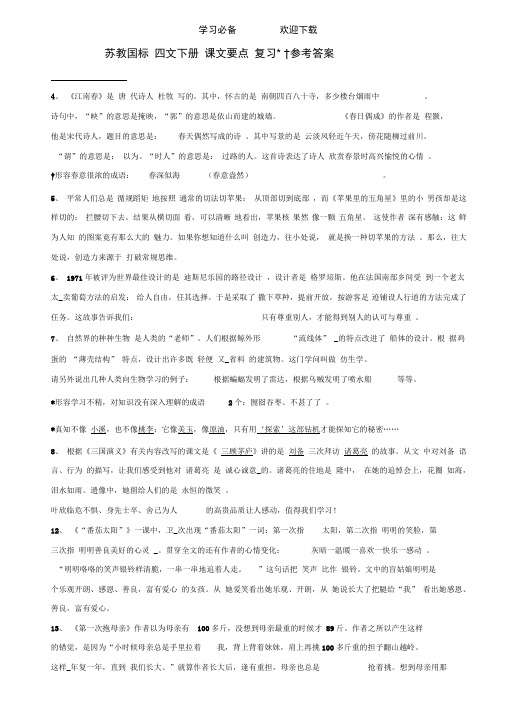
苏教国标四文下册课文要点复习* †参考答案4、《江南春》是唐代诗人杜牧写的。
其中,怀古的是南朝四百八十寺,多少楼台烟雨中。
诗句中,“映”的意思是掩映,“郭”的意思是依山而建的城墙。
《春日偶成》的作者是程颢,他是宋代诗人,题目的意思是:春天偶然写成的诗。
其中写景的是云淡风轻近午天,傍花随柳过前川。
“谓”的意思是:以为。
“时人”的意思是:过路的人。
这首诗表达了诗人欣赏春景时高兴愉悦的心情。
†形容春意很浓的成语:春深似海(春意盎然)。
5、平常人们总是循规蹈矩地按照通常的切法切苹果:从顶部切到底部,而《苹果里的五角星》里的小男孩却是这样切的:拦腰切下去。
结果从横切面看,可以清晰地看出,苹果核果然像一颗五角星。
这使作者深有感触:这鲜为人知的图案竟有那么大的魅力。
如果你想知道什么叫创造力,往小处说,就是换一种切苹果的方法。
那么,往大处说,创造力来源于打破常规思维。
6、1971年被评为世界最佳设计的是迪斯尼乐园的路径设计,设计者是格罗培斯。
他在法国南部乡间受到一个老太太_卖葡萄方法的启发:给人自由,任其选择。
于是采取了撒下草种,提前开放,按游客足迹铺设人行道的方法完成了任务。
这故事告诉我们:只有尊重别人,才能得到别人的认可与尊重。
7、自然界的种种生物是人类的“老师”。
人们根据鲸外形“流线体” _的特点改进了船体的设计。
根据鸡蛋的“薄壳结构” 特点,设计出许多既轻便又_省料的建筑物。
这门学问叫做仿生学。
请另外说出几种人类向生物学习的例子:根据蝙蝠发明了雷达,根据乌贼发明了喷水船等等。
*形容学习不精,对知识没有深入理解的成语2个:囫囵吞枣、不甚了了。
*真知不像小溪,也不像桃李;它像美玉,像原油,只有用‘探索’这部钻机才能探知它的秘密……8、根据《三国演义》有关内容改写的课文是《三顾茅庐》讲的是刘备三次拜访诸葛亮的故事。
从文中对刘备语言、行为的描写,让我们感受到他对诸葛亮是诚心诚意_的。
诸葛亮的住地是隆中,在她的追悼会上,花圈如海,泪水如雨。
GRE填空从零基础到满分全套备考教材指南

GRE填空从零基础到满分全套备考教材指南GRE填空从零基础到满分全套备考教材推举指南,一起来学习一下吧,下面我就和大家共享,来观赏一下吧。
GRE填空从零基础到满分全套备考教材推举指南GRE填空备考需摆脱词汇至上想法虽然如今GRE考试已经进入了新G时代,但老GRE的一些陈旧观点,至今仍在不少地方大行其道。
对于GRE填空来说,还是有许多考生会带着填空就是考词汇的观点来看待复习,更重视对词汇的把握而忽视解题技巧的磨练。
而这些考生在选择教科书时受此影响也会更偏向于一些过于强调词汇,内容有失偏颇的教材。
实际上,如今的新GRE考试,虽然仍对词汇有较高要求,但也大幅度加强了对于各类规律思维方面解题技巧的考察,假如考生没有这方面的阅历,只想靠着词汇量硬吃填空题,那么往往会铺张掉大量的时间,解题效率会变得相当低下。
因此,我盼望大家在复习之前首先能调整好思路,明确一个观点,那就是如今的新GRE已经不是词汇为王的考试了。
缺乏相应的解题技巧和思维方式,你的GRE复习迎考之路将荆棘遍布。
GRE填空备考不同进度水平资料教材推举依据考生目前所出的备考层次,我为大家推举每个复习阶段最适合各位考生的复习教材。
1. 新手初期打基础《GRE填空基础24套》:来自GRE名师陈琦老师的入门级教材,对于考G新手来说足够友好,题目难度适中,在解题技巧特殊是涉及规律思维的部分很有价值,适合考生在GRE备考初期使用。
《陈圣元GRE句子填空》:备考GRE句子填空题不行多得的一份资料。
书里题目全部是老G真题填空题,新G尽管已经改革,但是这本书的作用仍旧毋庸置疑。
本书含有详尽的翻译和解题说明,使得考生不至于在茫茫题海中迷失。
《新GRE高频词汇:句子填空》:收词于GRE真题,科学排序,释义精准,备考事半功倍。
同时,例句选自真题,为考生供应高度仿真语境,并配以中文翻译,关心考生更好地理解、学习。
2. 进阶备考提难度《新gre填空教程》(绿皮):全书收录了单空题部分、双空题部分、三空题部分、新GRE填空补充练习题共67个Exercise近600道题目。
陈圣元句子填空心法完整版

序本文提供一种复习GRE句子填空的模板,包括解题步骤总结和1993年2月和4月国内题填空的复习范例。
其中解题步骤总结主要来自陈圣元《句子填空》和新东方课堂笔记。
复习填空时,先从文字档案格式的真题中将填空题在WORD中COPY到一起,然后再按本文方式复习。
按这种方式复习虽然多耗一点时间,但通过强化却能够培养起对填空中信号词和中心词的极度敏感,从而快速准确解题。
本人通过试用,填空已从菜鸟水平提高至高手行列。
若有错漏,敬请指正。
希望对大家有所帮助。
1.范例2.粉红色:标示表逻辑关系或作者褒贬态度的信号词,以及标示大粘连和小粘连结构中表信息重复方式的信号词,还标示表分隔的信号词3.蓝色:标示与空格对应的中心词4.青色:标示句子中已出现的成对的对应词(同义或反义)5.“+"放在相应空格位置表示正或褒态度;“-"放在相应空格位置表示负或贬态度6.红色:标示不认识的生词单箭头:由中心词指向相应空格双箭头:指向两个空格表明两空应同时做箭头爲红色表示反义箭头爲黑色表示同义7.红色“*”号:放在题干后表明本题爲错题或难题8.题干后也可简要注明解题要点一、句子填空解题步骤分析句子结构:分隔与粘连是主要的重复信息的方式。
分隔:句子中对主干进行修饰或补充的成分。
定语从句:that 同位语:that who “, ”插入语:“, ”分词结构:分词不定式结构:to 介词短语:介词粘连:由分号或冒号分开的上下句结构(大粘连)和一个句子内部的直接简单重复(小粘连)。
1.大粘连:直接同义重复:并列、因果关系词A.双重否定与肯定句重复:(1)A, not 非A (2)A, It's wrong/foolish/presumptuous to say 非AB.主动句与被动句重复:is the result of, is the outgrowth of, is the product of A(B;B(by AC.逆否命题重复:A(B;非B(非A(无被动句标志词)D.比较句重复:to the same degree/extent, as…as, more/less, -er, better, thanE.手段目的句重复:by for in terms ofF.特殊并列句重复:包含两个并列关系从句的句式G.时间对比句重复:once, formerly, initial, pristine, erstwhile, hereto, hitherto, now, futurebefore, recent, begin, start, create, until, no longer, previousH.比喻句重复:like as2.小粘连:and but rather than even as…as so…as to…A.判断句子逻辑关系:找出信号词,判断句子的并列、转折关系和正(+)、反(-)态度关系。
全新版大学综合英语教程2课后填空题目及句子翻译Unit3-Unit8
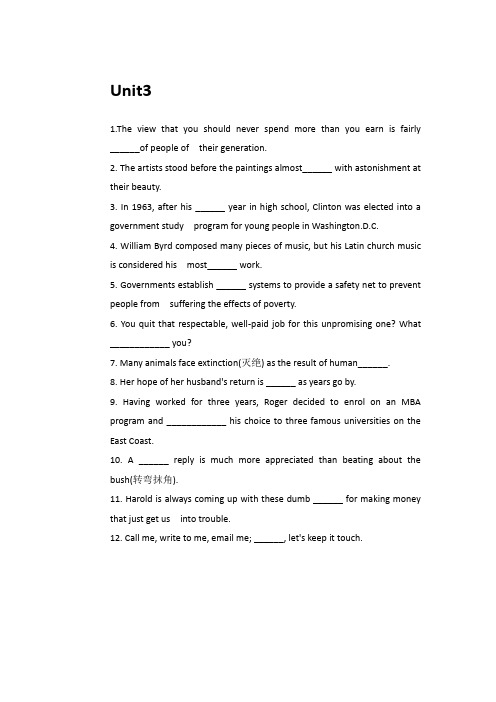
Unit31.The view that you should never spend more than you earn is fairly ______of people of their generation.2. The artists stood before the paintings almost______ with astonishment at their beauty.3. In 1963, after his ______ year in high school, Clinton was elected into a government study program for young people in Washington.D.C.4. William Byrd composed many pieces of music, but his Latin church music is considered his most______ work.5. Governments establish ______ systems to provide a safety net to prevent people from suffering the effects of poverty.6. You quit that respectable, well-paid job for this unpromising one? What ____________ you?7. Many animals face extinction(灭绝) as the result of human______.8. Her hope of her husband's return is ______ as years go by.9. Having worked for three years, Roger decided to enrol on an MBA program and ____________ his choice to three famous universities on the East Coast.10. A ______ reply is much more appreciated than beating about the bush(转弯抹角).11. Harold is always coming up with these dumb ______ for making money that just get us into trouble.12. Call me, write to me, email me; ______, let's keep it touch.1) 科学家们找到火星上有水的证据了吗?(proof)Have scientists found proof of water on Mars?2) 计划委员会已经将建核电厂的可能地点缩小到了两个沿海城镇。
必修3各单元单句语法填空、句型、单句改错(word版有答案)

必修3各单元语法填空、句子、翻译、单句改错目录必修3各单元语法填空、句子、翻译、单句改错 (1)Unit 1 Book 3 (1)Unit 2 Book 3 (3)Unit 3 Book 3 (5)Unit 4 Book 3 (7)Unit 5 Book 3 (9)必修3各单元语法填空、句子、翻译、单句改错答案 (11)Keys: Unit 1 Book 3 (11)Keys: Unit 2 Book 3 (11)Keys: Unit 3 Book 3 (12)Keys: Unit 4 Book 3 (13)Keys: Unit 5 Book 3 (13)Unit 1 Book 3一、单句语法填空1. There was Lucy ________ (wave) at him.2. ________ (find) that he was sad, his mother decided to cheer him up.3. Gandhi h elped gain India’s ________ (independent) from Britain.4. These carnivals include parades. Loud music and colourful clothing ________ all kinds.5. He thought she would keep ________ word.6. Mr. Li sat down and turned on the TV is just ________ he needed!7. The couple left the shop ________ (secret).8. We don’t like the ________ (origin) designs of this house.9. In China ,people celebrate the Qingming Festival ________ early April.10. The man spent the rest of his life in America, ________ he was buried in 1978.11. That was the first time that my parents ________ (learn) my disappointed behaviour at school.12. The little girl, together with her friends , ________ (dress) in pink today.13. It looks as ________ it’s going to rain.14. Every student is looking forward to the ________ (arrive) of the good news.15. New Year’s Day may be ________ day of rest.16. It’s too late. The boss ________ not come.17. Lily has won the competition three times. She ________ be very clever.18. He’s ten years old, be he still ________ not read.19. You ________ (come) to the party yesterday, but why didn’t you?20. When we were children, we ________ go skating every winter.二、句子考查21. Obviously, he was very embarrassed.________ ________ ________ ________ he was very embarrassed.22. My coat which was covered with mud was bought just a week ago.My coat ________ ________ ________ was bought just a week ago.23. If they don't give us a treat, we can make fun of them.If they don't give us a treat, we can ________ ________ ________ ________ them.24. 假如我忘记了,请提醒一下我的诺言。
Guidance
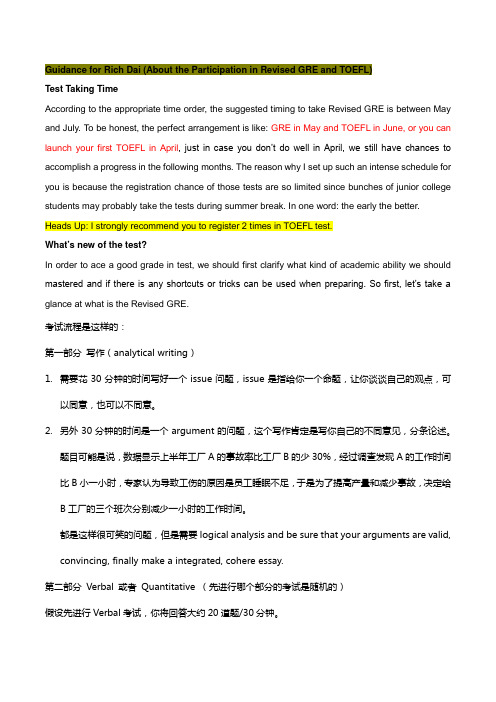
Guidance for Rich Dai (About the Participation in Revised GRE and TOEFL)Test Taking TimeAccording to the appropriate time order, the suggested timing to take Revised GRE is between May and July. To be honest, the perfect arrangement is like: GRE in May and TOEFL in June, or you can launch your first TOEFL in April, just in case you don’t do well in April, we still have chances to accomplish a progress in the following months. The reason why I set up such an intense schedule for you is because the registration chance of those tests are so limited since bunches of junior college students may probably take the tests during summer break. In one word: the early the better.Heads Up: I strongly recommend you to register 2 times in TOEFL test.What’s new of the test?In order to ace a good grade in test, we should first clarify what kind of academic ability we should mastered and if there is any shortcuts or tricks can be used when preparing. So first, let’s take a glance at what is the Revised GRE.考试流程是这样的:第一部分写作(analytical writing)1.需要花30分钟的时间写好一个issue问题,issue是指给你一个命题,让你谈谈自己的观点,可以同意,也可以不同意。
中考人教版八年级语文下册专题6基础综合(解析版)
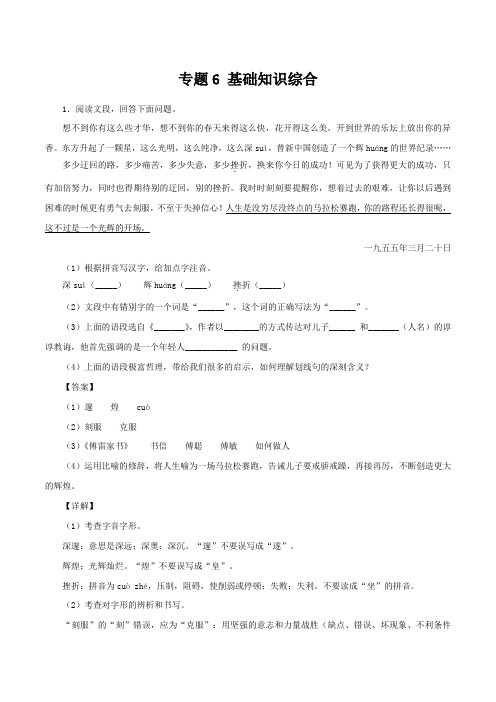
专题6 基础知识综合1.阅读文段,回答下面问题。
想不到你有这么些才华,想不到你的春天来得这么快,花开得这么美,开到世界的乐坛上放出你的异香。
东方升起了一颗星,这么光明,这么纯净,这么深suì,替新中国创造了一个辉huáng的世界纪录……多少迂回的路,多少痛苦,多少失意,多少挫.折,换来你今日的成功!可见为了获得更大的成功,只有加倍努力,同时也得期待别的迂回,别的挫折。
我时时刻刻要提醒你,想着过去的艰难,让你以后遇到困难的时候更有勇气去刻服,不至于失掉信心!人生是没穷尽没终点的马拉松赛跑,你的路程还长得很呢,这不过是一个光辉的开场。
一九五五年三月二十日(1)根据拼音写汉字,给加点字注音。
深suì(_____)辉huáng(_____)挫.折(_____)(2)文段中有错别字的一个词是“______”,这个词的正确写法为“______”。
(3)上面的语段选自《_______》,作者以________的方式传达对儿子______ 和_______(人名)的谆谆教诲,他首先强调的是一个年轻人____________ 的问题。
(4)上面的语段极富哲理,带给我们很多的启示,如何理解划线句的深刻含义?【答案】(1)邃煌cuò(2)刻服克服(3)《傅雷家书》书信傅聪傅敏如何做人(4)运用比喻的修辞,将人生喻为一场马拉松赛跑,告诫儿子要戒骄戒躁,再接再厉,不断创造更大的辉煌。
【详解】(1)考查字音字形。
深邃:意思是深远;深奥;深沉。
“邃”不要误写成“遂”。
辉煌:光辉灿烂。
“煌”不要误写成“皇”。
挫折:拼音为cuò zhé,压制,阻碍,使削弱或停顿;失败;失利。
不要读成“坐”的拼音。
(2)考查对字形的辨析和书写。
“刻服”的“刻”错误,应为“克服”:用坚强的意志和力量战胜(缺点、错误、坏现象、不利条件等)。
克,汉语通用规范一级汉字(常用字) ,拼音kè ,最早见于甲骨文。
陈圣元填空
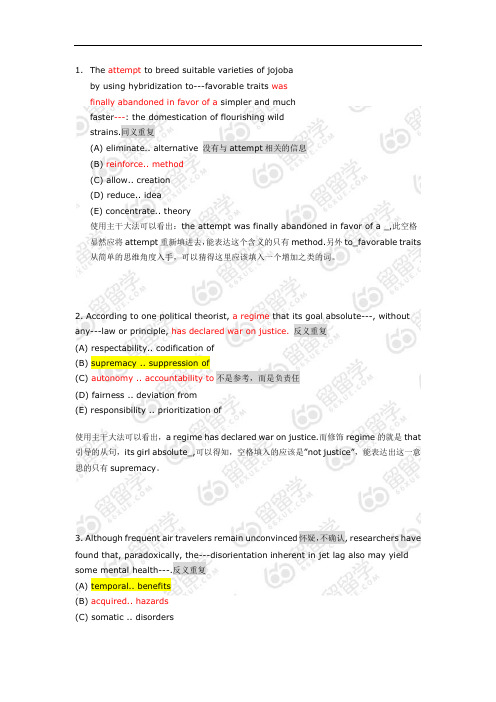
1.The attempt to breed suitable varieties of jojobaby using hybridization to---favorable traits wasfinally abandoned in favor of a simpler and muchfaster---: the domestication of flourishing wildstrains.同义重复(A) eliminate.. alternative 没有与attempt相关的信息(B) reinforce.. method(C) allow.. creation(D) reduce.. idea(E) concentrate.. theory使用主干大法可以看出:the attempt was finally abandoned in favor of a _,此空格显然应将attempt重新填进去,能表达这个含义的只有method.另外to_favorable traits 从简单的思维角度入手,可以猜得这里应该填入一个增加之类的词。
2. According to one political theorist, a regime that its goal absolute---, without any---law or principle, has declared war on justice. 反义重复(A) respectability.. codification of(B) supremacy .. suppression of(C) autonomy .. accountability to不是参考,而是负责任(D) fairness .. deviation from(E) responsibility .. prioritization of使用主干大法可以看出,a regime has declared war on justice.而修饰regime的就是that 引导的从句,its girl absolute_,可以得知,空格填入的应该是”not justice”,能表达出这一意思的只有supremacy。
陈圣元句子填空

陈圣元句子填空陈圣元句子填空方法之一:并列关系同义词解法并列关系最典型的一个连接词便是"and"。
此外,indeed, just as, also, almost, even, similarly, correspondingly, accordingly, in the same way 等亦属并列关系。
总之,凡是不含对立转折关系的大多可列入关列关系,解题时只需将相应的中心线索定位,找出一个同义词的选项即可。
例Ⅰ:When I watch drivers routinely slam their cars to a halt, --------- take corners on two wheels, and blunder wildly over construction potholes and railroad crossings, I consider it a --------- to automotive design that cars don’t shake apart far sooner.(A) gradually ... curiosity(B) sensibly ... blessing(C) gracefully ... misfortune(D) habitually ... tribute(E) religiously ... instruction〖解答〗先处理空格Ⅰ。
以When引导的从句描述了汽车司机的三个连贯动词,彼此以and连接,每个动词均以副词加以修辞,可将第一个动作slam前头的副词routinely 移入空格,则求得其唯一的同义词(D) habitually。
空格Ⅱ:“I consider it ... ”中的“it ”指"that cars don’t shake apart far sooner", 故代入空格II的名词应对此作出概括,(D)tribute为最佳,(B) blessing尚可。
GRE填空题最全题型汇总及复习攻略

GRE填空题最全题型汇总及复习攻略新手预备GRE填空题探秘,全题型汇总及复习攻略大公开。
下面我就和大家共享,来观赏一下吧。
新手预备GRE填空题探秘最全题型汇总及复习攻略大公开新GRE填空题备考方法:制定复习方案要备考GRE填空题,好的复习方案不行少。
做到以下几点很有必要。
1. 背诵并深刻理解词汇书(比如红宝书等)上面的填空部分的单词。
并根据考试新要求,自行整理并分类别收集词汇。
2. 脚踏实地的提高自身英语水平,充分重视长句和难句的阅读力量的提升。
3. 认真仔细的讨论过去消失过的考试真题。
应当把真题乐观利用起来,而不是消极做题,还要根据样题的思路来分析ETS的出题思路,比如题干可以做哪些调整,题目单词可以加入哪些做替换等等。
备考新GRE填空要点介绍1. 规律。
看到GRE考试填空题之后,很快的去思索这道题是在强调一个什么样的规律。
相等?相反?强调?进一步解释?或者并列?与其反复的去看题目,不如很直接的抓住句子中的规律关系,这样就知道了解题的方向了。
2. 关键词。
找到了规律关系之后,就抓住了解题的方向。
在有了大的方向的状况下,找到关键词,便可以很快的解题了。
3. 练习与反思。
假如没有时间大量的去练习,也至少应当花一部分的时间出来去反思做错的题目,是由于单词不会?还是规律没把握住?还是其它的缘由。
有反思,才有进步。
盲目的努力,只是在给自己的失败找借口。
推举新GRE填空备考资料1. 《陈圣元句子填空》。
填空的入门资料,每套题后面都有很具体的解释,是最佳的入门练习。
2. 陈琦《填空7套》。
有肯定的针对性。
做完之后肯定要反思,反思,再反思。
假如能够结合陈琦的录音反思,那么效果就更好了。
3. 《绿皮填空》。
这个里面有许多题目是和前面两个资料重复的。
不过这也是最接近现在考试题目类型的练习。
用来作为后期练习最好。
新GRE填空题难度分析可以看出,新GRE填空题的题目难度主要来自于对单词理解和规律的分析,段落题目要将全部空格填完并且完全正确才得分,单句题目要两个选项都入选才算正确,对考生的词汇量和规律分析力量有较高的要求,也是考生需要加强复习的重点。
统编版六年级下册第四单元复习专项—按课文内容填空(含答案+详细解析)

统编版六年级下册第四单元复习专项—按课文内容填空(含答案+详细解析)第四单元专项训练——按课文内容填空班级:_________ 姓名:__________1.课文内容回顾。
(1)《马诗》中最能表达诗人想要实现理想的迫切心情的诗句是:“________,________。
”体现作者________的愿望。
(2)《石灰吟》中暗喻面临严峻考验却能从容不迫的诗句是:“________,________。
”这句用了______的修辞手法。
(3)《竹石》作者是________,是“________”之一,他的____________被称为“三绝?中比喻历经磨难,依然坚强的诗句是:“________,________________。
”(4)三首古诗分别表达了诗人怎样的志向?表达的方法有什么共同特点?_________________________(5)《十六年前的回忆》是一篇回忆录。
作者_______采用第_____人称的叙述方式,回忆了________的全过程。
展示了革命先烈________的伟大精神和面对敌人____________的高贵品质,表达了作者对父亲的敬仰与深切的怀念。
本文是按照_________顺序写的,主要写了________、________、_______、________这几件事。
(6)《为人民服务》是一篇演讲稿,是______于1944年9月8日在_______同志的追悼会上所作的演讲,课文围绕“____________”讲了四个问题:如何对待__________,如何对待________,如何对待________,如何对待__________。
号召大家学习__________的精神,团结起来,打败敌人。
(7)《董存瑞舍身炸暗堡》这个故事按________顺序写的。
故事的起因:________,经过是__________ ,结果是_______。
赞扬了董存瑞________的精神。
个人经验--新GRE复习资料
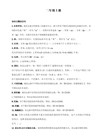
【个人点评】我还是买的纸质的。。。这本书不是很厚,里面讲解的方法和cracking大体相同,配有练习,可以参考。
3. [选读] 新东方绿皮 -- 新东方新G教材。
【个人点评】对于绿皮这一套我个人并不推荐使用,在此首先声明我并无对新东方老师们水平和劳动成果的质疑。这套书是新东方老师集体编纂的,其来源基本上都是改编自老G的真题,但是这与ETS的出题思路上不免有不一致的情况,并且难度上参差不齐。
10. [选读] 新GRE核心词汇-考法精析(再要你命3000) -- 新东方陈琦编纂的GRE单词书,词汇量3K+。
【个人点评】新东方传奇人物琦叔的要你命3K的新G版本,对于这本书褒贬不一。个人认为老G时代琦叔3K名冠江湖绝对是真才实料,其被封为类反圣经,即便是红宝也要怯其三分,而且经久不衰,不断传奇再现; however, well, you know...
2. [选读] 北美范文 -- 传说中的北美范文。
【个人点评】首先这本书目前没有新G版本,其次这本书中不是所有文章都在5分以上。所以这本书学语言可以,其他的就算了,仅供参考。
3. [不读] 大绿皮AW分册 -- crap
【个人点评】不解释。
4. [选读] 网上各种版本破题集 -- 网上破题的人很多,更有很多新东方老师在做这件事。
【个人点评】别人的老婆是别人的老婆,别人的大脑也一样是别人的大脑。你看了别人的老婆,你也顶多就是看看,娱乐还得基本靠手,所以你看了别人的破题,你也一样顶多是看看,考试还是得靠你自己。
5. [选读] College Writing Skills with readings -- 一本非常好的讲解英文写作的书。
5. [选读] 数学高分快速突破 -- 大蓝本中的数学分册,作者陈向东。书中是分了类的老G真题选集和讲解。
新教材高考语文一轮复习课时评价40语脉细梳理虚位以待君语句复位(含解析)新人教版

语脉细梳理虚位以待君——语句复位(建议用时:15分钟)1.填入①②横线上的语句,最恰当的一项是( )金沙江大峡谷旁有一座远近闻名的纳西古城,__①__,是纳西人最原始的聚居地。
我们步行了一个多小时,古城出现在前面。
__②__,上面镌刻着“宝山石头城”五个大字。
A.①古城建在一块庞大独立的蘑菇状岩石上②远远地就能看出那拱形城门的别具一格B.①一块庞大独立的蘑菇状岩石上建着古城②远远地就能望见那别具一格的拱形城门C.①一块庞大独立的蘑菇状岩石上建着古城②远远地就能看出那拱形城门的别具一格D.①古城建在一块庞大独立的蘑菇状岩石上②远远地就能望见那别具一格的拱形城门D 解析:根据就近原则和陈述对象一致性原则,①句应填“古城建在一块庞大独立的蘑菇状岩石上”,“古城”和上一句较连贯,又能作下一句的主语;②处应填“远远地就能望见那别具一格的拱形城门”,因为“拱形城门”与后一句“上面”承接较紧密,而“远远地就能看出那拱形城门的别具一格”强调的是“别具一格”。
2.填入①②横线上的语句,最恰当的一项是( )每逢深秋季节,__①__,松竹山茶,色彩绚丽,美景尽览。
远眺群山环抱,__②__;近看小河流水,茶院葱绿,松竹并茂。
①置身山顶,俯瞰槐榆丹枫②置身山顶俯瞰,槐榆丹枫③白云缭绕,层林叠翠④层林叠翠,白云缭绕A.①③ B.①④ C.②③ D.②④D 解析:“每逢”为六字句,若选①,“置身山顶”是四字句,“俯瞰槐榆丹枫”又是六字句,显然参差杂乱,极不整齐;若选②,两个六字句相对,接下来是四个四字句,不仅句式对称,而且“瞰”与“览”也押韵。
“远眺”与“近看”形成对称,后面各跟三个四字句。
但从押韵上看,若选③,韵脚是“抱”“翠”“水”“茂”,显然读起来不大和谐;若选④,韵脚则成了“抱”“绕”“水”“茂”,韵脚和谐自然,表达流畅自如。
选③显然没有选④好。
3.填入甲、乙两段话中括号内的语句,最恰当的一项是( )甲:小河上的薄冰融化已尽,小草从暖融融的泥土中苏醒,( ①),造化的神功又一次使人们惊异了。
出国考试:GRE考试全攻略,GRE新手看过来

出国考试:GRE考试全攻略,GRE新⼿看过来 关于GRE考试如何复习,如何备考,GRE新⼿肯定还存在着疑惑。
我想不只是新⼿,就算是已经经历过GRE考试的考⽣也会有⼀些不知道该如何复习的。
所以今天店铺就要带着你们⼀起看看GRE考试到底该如何备考,店铺将会从GRE考试的各个部分来进⾏说明。
GRE考试 ⼀、GRE单词复习攻略 1. 背单词是GRE复习的必修课,没什么捷径,就是反复背。
2. 单词的背诵在整个复习的过程中都不能中断,要坚持刷,不断地巩固⾃⼰的记忆。
3. 然后在最后2周刷再要你命3000,3000好在帮你把同义词都整理在⼀起了,当然要是你没有较好的红宝的基础,看起来会⽐较吃⼒,所以还是先刷红宝打基础,⽤新3000巩固。
⼆、GRE阅读复习攻略 1. 对于阅读刚开始起步的同学,花⼉阅读绝对是神器!花⼉阅读能让你对GRE的阅读有⼀个全⾯的认识,对于备考周期短的同学完全可以3天刷掉花⼉阅读。
2. 接着考⽣就可以做陈虎平36套,可以按每天2套的速度来做,前16套因为题⽬较多不⽤限时,主要以分析⽂章,得出正确答案为主,到17套以后的题⽬,应该尽量在18分钟内定时完成。
3. 还有新G⽼G阅读的变化就是增加了逻辑题,对于那些认为逻辑题很难经常会错的同学,可以练练陈虎平的'逻辑10套。
三、GRE写作复习攻略 1. 先看北美范⽂,对issue有⼀个⼤概的感觉,开始拟⼀个Argu的粗略模版。
同时背⼀些issue范⽂,学习范⽂语⾔,找感觉。
对于打字速度慢的考⽣,建议⽤范⽂练习打字,既熟悉了范⽂⼜提⾼了打字速度,⼀举两得。
2. 然后分类列Issue提纲。
列提纲的过程中,先⾃⼰想想,然后可以参考G友们的思路,⽽且最好分类列提纲(按⽹上通⽤的那11类分类法)。
3. 列Argu提纲。
考⽣可以把所有的Argu题⽬都过三遍:第⼀遍,熟悉题⽬,认识⽣词。
第⼆遍,把每⼀道题都列提纲,就是把逻辑错误简要⽤中⽂写出来。
- 1、下载文档前请自行甄别文档内容的完整性,平台不提供额外的编辑、内容补充、找答案等附加服务。
- 2、"仅部分预览"的文档,不可在线预览部分如存在完整性等问题,可反馈申请退款(可完整预览的文档不适用该条件!)。
- 3、如文档侵犯您的权益,请联系客服反馈,我们会尽快为您处理(人工客服工作时间:9:00-18:30)。
711. A computer program can provide information in ways that force students to ________ learning instead of being merely ________ of knowledge.(A) shore up ... reservoirs(B) accede to ... consumers(C) participate in ... recipients(D) compensate for ... custodians(E) profit from ... beneficiaries2. The form and physiology of leaves vary according to the ________ in which they develop: for example, leaves display a wide range of adaptations to different degrees of light and moisture.(A) relationship(B) species(C) sequence(D) patterns(E) environment3. One theory about intelligence sees ________ as the logical structure underlying thinking and insists that since animals are mute, they must be ________ as well.(A) behavior ... inactive(B) instinct ... cooperative(C) heredity ... thoughtful(D) adaptation ... brutal(E) language ... mindless4. Though ________ in her personal life, Edna St. Vincent Millay was nonetheless ________ about her work, usually producing several pages of complicated rhyme in a day.(A) jaded ... feckless(B) verbose ... ascetic(C) vain ... humble(D) impulsive ... disciplined(E) self-assured ... sanguine5. The children's ________ natures were in sharp contrast to the even-tempered dispositions of their parents.(A) mercurial(B) blithe(C) phlegmatic(D) introverted(E) artless6. By ________ scientific rigor with a quantitative approach, researchers in the social sciences may often have ________ their scope to those narrowly circumscribed topics that arewell suited to quantitative methods.(A) undermining ... diminished(B) equating ... enlarged(C) vitiating ... expanded(D) identifying ... limited(E) imbuing ... broadened7. As early as the seventeenth century, philosophers called attention to the ________ character of the issue, and their twentieth-century counterparts still approach it with ________ .(A) absorbing ... indifference(B) unusual ... composure(C) complex ... antipathy(D) auspicious ... caution(E) problematic ... uneasiness721. Since most if not all learning occurs through ________ , relating one observation to another, it would be strange indeed if the study of other cultures did not also illuminate the study of our own.(A) assumptions(B) experiments(C) comparisons(D) repetitions(E) impressions2. The new ________ of knowledge has created ________ people: everyone believes that his or her subject cannot and possibly should not be understood by others.(A) specialization ... barriers between(B) decline ... associations among(C) redundancy ... complacency in(D) disrepute ... concern for(E) promulgation ... ignorance among3. If a species of parasite is to survive, the host organisms must live long enough for the parasite to ________ ; if the host species becomes ________, so do its parasites.(A) atrophy ... healthy(B) reproduce ... extinct(C) disappear ... widespread(D) succumb ... nonviable(E) mate ... infertile4. The author argues for serious treatment of such arts as crochet and needlework, finding in too many art historians a cultural blindness ________ to their ________ textiles as a medium in which women artists predominate.(A) traceable ... prejudice against(B) opposed ... distrust of(C) referring ... need for(D) reduced ... respect for(E) corresponding ... expertise in5. Those who fear the influence of television deliberately ________ its persuasive power, hoping that they might keep knowledge of its potential to effect social change from being widely disseminated.(A) promote(B) underplay(C) excuse(D) laud(E) suspect6. Because the high seriousness of their narratives resulted in part from their metaphysics, Southern writers werepraised for their ________ bent.(A) technical(B) discursive(C) hedonistic(D) philosophical(E) scientific7. Far from being ________ , Pat was always ________ to appear acquiescent.(A) unctuous ... loath(B) brazen ... reluctant(C) ignoble ... concerned(D) obsequious ... eager(E) gregarious ... willing731. Though ________ to some degree, telling a small lie sometimes enables one to avoid ________ another's feelings.(A) necessary ... mollifying(B) regrettable ... harming(C) unfortunate ... exaggerating(D) attractive ... considering(E) difficult ... resisting2. Perhaps because scientists have been so intrigued by dogs' superior senses of smell and hearing, researchers have long ________ their eyesight, assuming that they inhabit a drab, black-and-white world, devoid of color.(A) studied(B) coveted(C) appreciated(D) resented(E) underestimated3. Despite a string of dismal earnings reports, the two-year-old strategy to return the company to profitability is beginning to ----.(A) falter(B) disappoint(C) compete(D) work(E) circulate4. The President reached a decision only after lengthy------, painstakingly weighing the ----opinions expressed by cabinet members.(A) deliberation.. divergent(B) confrontation.. unanimous(C) relegation.. consistent(D) speculation.. conciliatory(E) canvassing.. arbitrary5. Although just barely ________ as a writer of lucid prose, Jones was an extremely ________ editor who worked superbly with other writers in helping them improve the clarity of their writing.(A) deficient ... muddling(B) proficient ... contentious(C) adequate ... capable(D) appalling ... competent(E) engaging ... inept6. The accusations we bring against others should be ________ ourselves; they should not ________ complacency and easy judgments on our part concerning our own moral conduct.(A) definitions of ... produce(B) instructions to ... equate(C) denigrations of ... exclude(D) warnings to ... justify(E) parodies of ... satirize7. Although the meanings of words may necessarily be liable to change, it does not follow that the lexicographer is therefore unable to render spelling, in a great measure, ________.(A) arbitrary(B) superfluous(C) interesting(D) flexible(E) constant741. Some activists believe that because the health-care system has become increasingly ________ to those it serves, individuals must ________ bureaucratic impediments in order to develop and promote new therapies.(A) attuned ... avoid(B) inimical ... utilize(C) unresponsive ... circumvent(D) indifferent ... supplement(E) sensitized ... forsake2. The acts of vandalism that these pranksters had actually ________ were insignificant compared with those they had ________ but had not attempted.(A) hidden ... renounced(B) advocated ... meditated(C) inflicted ... dismissed(D) committed ... effected(E) perpetrated ... contemplated3. Though one cannot say that Michelangelo was an impractical designer, he was, of all nonprofessional architects known, the most ________ in that he was the least constrained by tradition or precedent.(A) pragmatic(B) adventurous(C) empirical(D) skilled(E) learned4. Before adapting to changes in values, many prefer to ________ , to ________ the universally agreed-on principles that have been upheld for centuries.(A) innovate ... protect(B) resist ... defend(C) ponder ... subvert(D) vacillate ... publicize(E) revert ... ignore5. Although the records of colonial New England are ________ in comparison with those available in France or England, the records of other English colonies in America are even more(A) sporadic ... irrefutable(B) sparse ... incontrovertible(C) ambiguous ... authoritative(D) sketchy ... fragmentary(E) puzzling ... unquestionable6. High software prices are frequently said to ________ widespread illegal copying, although the opposite—that high prices are the cause of the copying—is equally plausible.(A) contribute to(B) result from(C) correlate with(D) explain(E) precede7. Because early United States writers thought that the mark of great literature was grandiosity and elegance not to be found in common speech, they ________ the vernacular.(A) dissected(B) avoided(C) misunderstood(D) investigated(E) exploited751.While scientists dismiss as fanciful the idea of sudden changes in a genetic code (spontaneous mutation), it is possible that nature, like some master musician,---- on occasion, departing from the expected or predictable.(A) repeats(B) improvises(C) ornaments(D) corrects(E) harmonizes2.Despite the _____ of time, space, and history, human societies the world over have confronted the same existential problem s and have come to remarkably _____ solutions, differing only in superficial details.Despite the _____ of time, space, and(A) continuit y…identical◦(B) uniformity…diverse◦(C) actualities…varied◦(D) contingencies…similar◦(E) exigencies…unique3. Although he was known to be extremely_________ in his public behavior, scholars have discovered that his diaries were written with uncommon_________.(A) reserved.. frankness(B) polite.. tenderness(C) modest.. lucidity(D) reticent.. vagueness(E) withdrawn.. subtlety4. With the_________ of scientific knowledge, work on the new edition of a textbook begins soon after completion of the original.(A) limitation(B) culmination(C) veneration(D) certainty(E) burgeoning5. She is most frugal in matters of business, but in her private life she reveals a streak of ________.(A) antipathy(B) misanthropy(C) virtuosity(D) equanimity(E) prodigality6. If the state government's latest budget problems were_________, it would not be useful to employ them as_________ examples in the effort to avoid the inevitable effects of shortsighted fiscal planning in the future.(A) typical.. representative(B) exceptional.. aberrant(C) anomalous.. illuminating(D) predictable.. helpful(E) solvable.. insignificant7. J ust as some writers have_________ the capacity of language to express meaning, Giacometti_________ the failure of art to convey reality.(A) scoffed at .. abjured(B) demonstrated.. exemplified(C) denied.. refuted(D) proclaimed.. affirmed(E) despaired of .. bewailed76.1. In spite of the fact that it is convenient to divide the life span of animals into separate stages such as pre-natal, adolescent, and senescent, these periods are not really ________.(A) advanced(B) variable(C) repeatable(D) connected(E) distinct2. Although the number of reported volcanic eruptions has risen exponentially since 1850, this indicates not_________volcanic activity but rather more widespread and_______ record keeping.(A) abating..detailed(B) increasing..systematic(C) substantial..erratic(D) stable..superficial(E) consistent..meticulous3. The challenge of interpreting fictional works written under politically repressive regimes lies in distinguishing what is_________ to an author's beliefs, as opposed to what is_________by political coercion.(A) innate.. understood(B) organic.. imposed(C) contradictory.. conveyed(D) oblique.. captured(E) peripheral.. demanded4. I am often impressed by my own ---- other people"s idiocies: what is harder to ---- is that they. In their folly, are equally engaged in putting up with mine.(A) analysis of.. justify(B) forbearance toward.. underestimate(C) exasperation with .. credit(D) involvement in .. allow(E) tolerance of .. appreciate5. Despite vigorous protestations, the grin on the teenager"s face ----her denial that she had known about the practical joke before it was played on her parents.(A) belied(B) illustrated(C) reinforced(D) exacerbated(E) trivialized6. Far from undermining the impression of permanent decline, the ---- statue, seemed emblematic of its ---- surroundings.(A) indecorous.. opulent(B) grandiose.. ramshackle(C) pretentious.. simple(D) ungainly.. elegant(E) tawdry.. blighted7. Despite the fact that it is almost universally ----, the practice of indentured servitude still ---- in many parts of the world.(A) condemned… abates(B) tolerated.. survives(C) proscribed.. persists(D) mandated.. lingers(E) disdained.. intervenes75(2)1. It is assumed that scientists will avoid making ________claims about the results of their experiments because of the likelihood that they will be exposed when other researchers cannot ________ their findings.(A) hypothetical ... evaluate(B) fraudulent ... duplicate(C) verifiable ... contradict(D) radical ... contest(E) extravagant ... dispute2. As long as the nuclear family is ________ a larger kinship group through contiguous residence on undivided land, the pressure to ________ and thus to get along with relatives is strong.(A) nurtured among ... abstain(B) excluded from ... compromise(C) embedded in ... share(D) scattered throughout ... reject(E) accepted by ... lead3. In contrast to the substantial muscular activity required for inhalation, exhalation is usually a ________ process.(A) slow(B) passive(C) precise(D) complex(E) conscious4. The documentary film about high school life was so realistic and ________ that feelings of nostalgia flooded over the college-age audience.(A) logical(B) pitiful(C) evocative(D) critical(E) clinical5. Although Georgia O'Keeffe is best known for her affinity with the desert landscape, her paintings of urban subjects ________ her longtime residency in New York City.(A) condemn(B) obfuscate(C) attest to(D) conflict with(E) contend with6. Even though the survey was designated as an interdisciplinary course, it involved no real ________ of subject matter.(A) encapsulation(B) organization(C) synthesis(D) discussion(E) verification7. The failure of many psychotherapists to ________ the results of pioneering research could be due in part to the specialized nature of such findings: even ________ findings may not be useful.(A) understand ... baffling(B) envision ... accessible(C) utilize ... momentous(D) reproduce ... duplicated(E) affirm ... controversial76(2)1. In the nineteenth century, novelists and unsympathetic travelers portrayed the American West as a land of ________ adversity, whereas promoters and idealists created ________ image of a land of infinite promise.(A) lurid ... a mundane(B) incredible ... an underplayed(C) dispiriting ... an identical(D) intriguing ... a luxuriant(E) unremitting ... a compelling2. Honeybees tend to be more ________ than earth bees: the former, unlike the latter, search for food together and signal their individual findings to one another.(A) insular(B) aggressive(C) differentiated(D) mobile(E) social3. Joe spoke of superfluous and ________ matters with exactly the same degree of intensity, as though for him serious issues mattered neither more nor less than did ________.(A) vital ... trivialities(B) redundant ... superficialities(C) important ... necessities(D) impractical ... outcomes(E) humdrum ... essentials4. The value of Davis' sociological research is compromised by his unscrupulous tendency to usematerials ________ in order to substantiate his own claims, while ________ information that points to other possible conclusions.(A) haphazardly ... deploying(B) selectively ... disregarding(C) cleverly ... weighing(D) modestly ... refuting(E) arbitrarily ... emphasizing5. Once Renaissance painters discovered how to ________ volume and depth, they were able to replace the medieval convention of symbolic, two-dimensional space with the more ________ illusion of actual space.(A) reverse ... conventional(B) portray ... abstract(C) deny ... concrete(D) adumbrate ... fragmented(E) render ... realistic6. He had expected gratitude for his disclosure, but instead he encountered ________ bordering on hostility.(A) patience(B) discretion(C) openness(D) ineptitude(E) indifference7. The diplomat, selected for her demonstrated patienceand skill in conducting such delicate negotiations,---- to make a decision during the talks because anysudden commitment at that time would have been ----.(A) resolved.. detrimental(B) refused.. apropos(C) declined.. inopportune(D) struggled.. unconscionable(E) hesitated.. warranted771. Because the monkeys under study are ---- the presence of human beings, they typically ----human observers and go about their business(A) ambivalent about .. welcome(B) habituated to .. disregard(C) pleased with .. snub(D) inhibited by .. seek(E) unaware of .. avoid2. Give he previously expressed interest and the ambitious tone of her recent speeches, the senator’s attempt to convince the public that she is not inter-ested in running for a second term is ----.(A) laudable(B) likely(C) authentic(D) futile(E) sincere3. Many of her followers remain ---- to her, and even those who have rejected her leadership are unconvinced of the ---- of replacing her during the current turmoil.(A) opposed.. urgency(B) friendly.. harm(C) loyal.. wisdom(D) cool.. usefulness(E) sympathetic.. disadvantage4. Unlike many recent interpretations of Beethoven’s piano sonatas, the recitalist’s per formance was a delightfully free and introspective one; nevertheless, it was also, seemingly paradoxically, quite ----.(A) appealing(B) exuberant(C) idiosyncratic(D) unskilled(E) controlled5. Species with relatively ---- metabolic rates, including hibernators, generally live longer than those whose metabolic rates are more rapid.(A) prolific(B) sedentary(C) sluggish(D) measured(E) restive6. Belying his earlier reputation for ---- as a negotiator, Morgan had recently assumed a more ---- stance for which many of his erstwhile critics praised him.(A) intransigence.. conciliatory(B) impropriety.. intolerant(C) inflexibility.. unreasonable(D) success.. authoritative(E) incompetence.. combative7. Although Irish literature continued to flourish after the sixteenth century, a ---- tradition is ---- in the visual arts: we think about Irish culture in terms of the word, not in terms of pictorial images.(A) rich.. superfluous(B) lively.. found(C) comparable.. absent(D) forgotten.. apparent(E) lost.. extant781. Although sales have continued to increase since last April, unfortunately the rate of increase has ________.(A) resurged(B) capitulated(C) retaliated(D) persevered(E) decelerated2. Although the mental process that creates a fresh and original poem or drama is doubtless ________ that which originates and elaborates scientific discoveries, there is clearly a discernible difference between the creators.(A) peripheral to(B) contiguous with(C) opposed to(D) analogous to(E) inconsistent with3. It is disappointing to note that the latest edition of the bibliography belies its long-standing reputation for ________ by ________ some significant references to recent publications.(A) imprecision ... appropriating(B) relevance ... adding(C) timeliness ... updating(D) meticulousness ... revising(E) exhaustiveness ... omitting4. Although Simpson was ingenious at ________ to appear innovative and spontaneous, beneath the ruse he remained uninspired and rigid in his approach to problem-solving.(A) intending(B) contriving(C) forbearing(D) declining(E) deserving5. She was criticized by her fellow lawyers not because she was not ________ , but because she so ________ prepared her cases that she failed to bring the expected number to trial.(A) well versed ... knowledgeably(B) well trained ... enthusiastically(C) congenial ... rapidly(D) hardworking ... minutely(E) astute ... efficiently6. Schlesinger has recently assumed a conciliatory attitude that is not ________ by his colleagues, who continue to ________ compromise.(A) eschewed ... dread(B) shared ... defend(C) questioned ... reject(D) understood ... advocate(E) commended ... disparage7. The National Archives contain information so ________ that researchers have been known never to publish because they cannot bear to bring their studies to an end.(A) divisive(B) seductive(C) selective(D) repetitive(E) resourceful791.We first became aware that her support for the new program was less than---- when she declined to make a speech in its favor.(A) qualified(B) haphazard(C) fleeting(D) unwarranted(E) wholehearted2. When a person suddenly loses consciousness, a bystander is not expected to ---- the problem but to attempt to ---- its effects by starting vital functions if they are absent(A) cure.. precipitate(B) minimize.. predict(C) determine.. detect(D) diagnose.. counter(E) magnify.. evaluate3. The remark was only slightly ----, inviting a chuckle, perhaps, but certainly not a ----.(A) audible.. reward(B) hostile.. shrug(C) amusing.. rebuke(D) coherent.. reaction(E) humorous.. guffaw4. Doors were closing on our past, and soon the values we had lived by would become so obsolete that we would seem to people of the new age as ----as travelers from an ancient land.(A) elegant(B) ambitious(C) interesting(D) comfortable(E) quaint5. Ability to ---- is the test of the perceptive historian:a history, after all, consists not only of what the historian has included, but also, in some sense, of what has been left out.(A) defer(B) select(C) confer(D) devise(E) reflect6. Some artists immodestly idealize or exaggerate the significance of their work, yet others ---- to exalt the role of the artist, reject a transcendent view of art(A) appearing(B) disdaining(C) seeking(D) failing(E) tending7. Estimating the risks of radiation escaping from a nuclear power plant is ---- questions, but one whose answer then becomes part of a value-laden, emotionally charged policy debate about whether to construct such a plant.(A) an incomprehensible(B) an undefined(C) an irresponsible(D) a divisive(E) a technicalSection 801. Because modern scientist find the ancient Greek view about cosmos outdated and irrelevant, they now perceive it as only of ____ interest.A) historicalB) intrinsicC) astronomicalA) experimentalD) superfluous2. Religious philosopher that he is, Henry More derived his conception of his infinite universe from the infinite God in whom he believed, a benevolent God of ____ whose nature was to create ____.A) plentitude ... abundanceB) vengeance ... justiceC) indifference .... sufferingD) indulgence ... temperanceE) rectitude ... havoc3. While some argue that imposing tolls on highway users circumvents the need to raise public taxes for road maintenance, the phenomenal expense of maintaining a vast network of roads------reliance on these general taxes.(A) avoids(B) diminishes(C) Necessitates(D) discourages(E)ameliorates4.Although they were not direct------,the new arts of the Classical period were clearly created in the spirit of older Roman models and thus------many features of the older style.(A) impressions introduced(B) translations accentuated(C) copies maintained(D) masterpieces depicted(E) borrowings improvised5. In spite of the increasing--------of their opinions, the group knew they had to arrive at a consensus so thatthe award could be presented(A) impartiality(B) consistency(C) judiciousness(D) incisiveness(E) polarity6. By forcing our surrender to the authority of the clock systematic timekeeping has imposed a form of-------on society.(A) anarchy(B) permanence(C) provincialism(D) tyranny(E) autonomy7. Our high-------vocabulary for street crime contrasts sharply with our------vocabulary for corporate crime, a fact that corresponds to the general public's unawareness of the extent of corporate crime.(A) nuanced ..subtle(B) uninformative ..misleading© euphemistic ..abstract(D) differentiated ..limited(E) technical ..jargon-laden811. What these people were waiting for would not have been apparent to others and was perhaps not very---their own minds.(A) obscure to(B) intimate to(C) illusory to(D) difficult for(E) definite in2. The attempt to breed suitable varieties of jojoba by using hybridization to---favorable traits was finally abandoned in favor of a simpler and much faster---: the domestication of flourishing wild strains.(A) eliminate.. alternative(B) reinforce.. method(C) allow.. creation(D) reduce.. idea(E) concentrate.. theory3. According to one political theorist, a regime that has as its goal absolute---, without any---law or principle, has declared war on justice.(A) respectability.. codification of(B) supremacy .. suppression of(C) autonomy .. accountability to(D) fairness .. deviation from(E) responsibility .. prioritization of4. Despite its ---, the book deals---with a number of crucial issues.(A) optimism .. cursorily(B) importance .. needlessly(C) virtues .. inadequately(D) novelty .. strangely(E) completeness .. thoroughly5. Although frequent air travelers remain unconvinced, researchers have found that,paradoxically, the---disorientation inherent in jet lag also may yield some mental health---.(A) temporal.. benefits(B) acquired.. hazards(C) somatic .. disorders(D) random .. deficiencies(E) typical .. standards6. Ironically, the proper use of figurative language must be based on the denotative meaning of the words, because it is the failure to recognize this---meaning that leads to mixed metaphors and their attendant incongruity.(A) esoteric(B) literal(C) latent(D) allusive(E) symbolic7. Although it seems---that there would be a greaterrisk of serious automobile accidents in densely populated areas, such accidents are more likely to occur in sparsely populated regions.(A) paradoxical(B) axiomatic(C) anomalous(D) irrelevant(E) portentous821. If the theory is self-evidently true, as its proponents assert, then why does---it still exist among well-informed people?(A) support for(B) excitement about(C) regret for(D) resignation about(E) opposition to2. Although the ---of cases of measles has ---,researchers fear that eradication of the disease,once believed to be imminent, may not come soon.(A) occurrence.. continued(B) incidence.. declined(C) prediction.. resumed(D) number.. increased(E) study.. begun3. Nothing---his irresponsibility better than his---delay in sending us the items he promised weeks ago.(A) justifies.. conspicuous(B) characterizes.. timely(C) epitomizes.. unnecessary(D) reveals.. conscientious(E) conceals.. inexplicable4. The author did not see the---inherent in her scathing criticism of a writing style so similar to her own.(A) disinterest(B) incongruity(C) pessimism(D) compliment(E) symbolism5. Whereas the Elizabethans struggled with the transition from medieval---experience to modern individualism, we confront an electronic technology that seems likely to reverse the trend,rendering individualism obsolete andinterdependence mandatory.(A) literary(B) intuitive(C) corporate(D) heroic(E) spiritual6. Our biological uniqueness requires that the effectsof a substance must be verified by---experiments,even after thousands of tests of the effects of thatsubstance on animals.(A) controlled(B) random(C) replicated(D) human(E) evolutionary7. Today water is more---in landscape architecture than ever before, because technological advances have made it easy, in some instances even ---to install water features in public places.(A) conspicuous.. prohibitive(B) sporadic.. effortless(C) indispensable.. intricate(D) ubiquitous.. obligatory(E) controversial.. unnecessary831. While many Russian composers of the nineteenth century contributed to an emerging national style, other composers did not_________ idiomatic Russian musical elements,_________ instead the traditional musical vocabulary of Western European Romanticism.(A) utilize ..rejecting(B) incorporate.. preferring(C) exclude.. avoiding(D) repudiate.. expanding(E) esteem.. disdaining。
